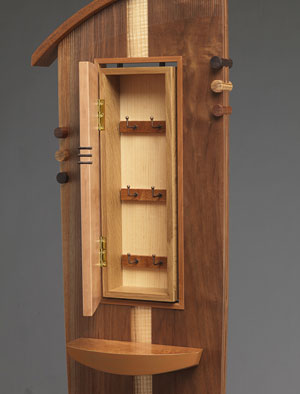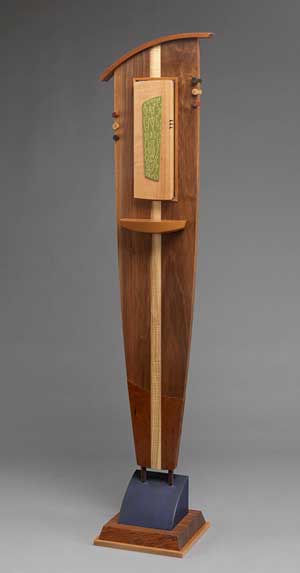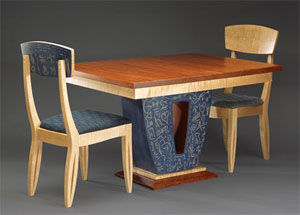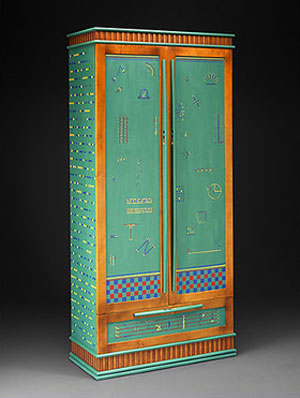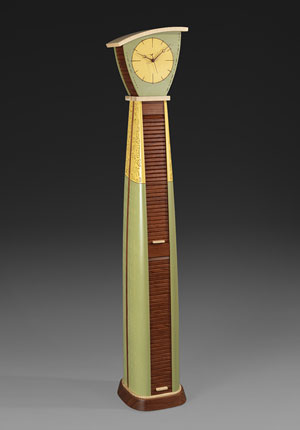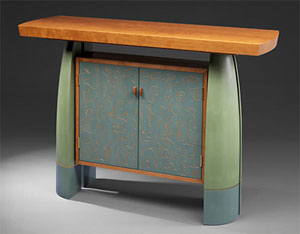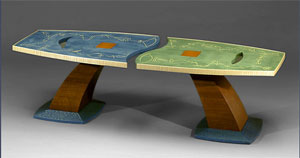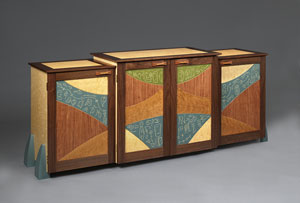
Mark DelGuidice says it was in his early twenties when working on a house project with a friend “awakened me to my hands.” At the time, he was studying psychology and personnel administration, and did not have a woodworking background.
After working with all aspects of the house, from assisting the carpentry crew to working on the cabinetry, Mark built some furniture for his apartment, a couple of stereo cabinets for friends — and then ended up in the Program in Artisanry at Boston University, which he called “a real game changer,” in terms of introducing him to concepts of design.
Mark has subsequently been working in woodworking for over 25 years, subsidizing his more artistic pieces with things like production work. “Skills are funny,” he said. “They come when you need them for a job. If I do something I haven’t done before” — like veneering several years ago — “for a job, then I incorporate it into my [art]work.”
He will also, he said, go through phases, where he may experiment with techniques, and stretch himself with “really funky pieces” before “I go back to work that’s not as oddball.” He used to keep veneering, carving and painting very separate, but after some of those experiments, he’s been incorporating those elements onto the same panel in pieces like last fall’s “Hallenza,” a credenza made for a family with the last name of Hallen.
Also evident on that piece is one of the trademarks of Mark’s designs: hieroglyphs made by incise carving. “They’ve always been in my head,” he explained. “It’s sort of like seeing things in the clouds; I’m seeing images in grains of wood.” Some of the hieroglyphs are literal renderings of specific figures (“you’ll see hearts and peace signs,” Mark said), some are abstract, “and some are specific to me.” When he’s showing his furniture at shows like those run by the American Craft Council, Mark said, “I will ask three different people ‘What do you see?’ and get three different explanations. You can sort of use it as a Rorschach test.”
Mark’s process in creating the pieces containing hieroglyphs is to draw out the images, carve, then paint. He uses a crooked-neck V parting tool, because “it allows me to almost draw with the carving tool.” For finishes, he will apply a coat of milk paint, then spray the piece with catalyzed varnish. “At BU, I was one of the few students who would paint furniture,” he said. “It goes back to my mother: I remember my mother painting furniture in the house.”
“I’m intrigued by the history of things, including furniture, Mark said, but, for himself, “It’s important for me to do nonderivative work. I strive for uniqueness.” Instead of doing reproductions, he expresses that interest in history with things like the Morse code found in some of his works. It runs down the side of his Garden Cupboard, the first piece he did with hieroglyphs, at a time when he was going through a divorce and his large vegetable garden was sustaining him.
“There’s a timeline to furniture that predates us by thousands of years. I’m just a dot along that line,” Mark said. “Furniture will outlive us, and Morse code is no long really used as a form of communication. We still know the words of Morse code, but in 100 years, I don’t think people will.”
Another “secret code” among Mark’s furniture is that, following the example of New Yorker cartoonist Al Hirschfeld, who incorporated the name of his daughter Nina into his line drawings, “I’m coming up on 25 years of carving my daughter’s name into all my work, ” Mark said. He tries to make the name “Ari” differently each time.
One of the pieces Mark has had success with over the years is a console for which he glues up blocks of all four legs with paper between them, then splits them apart when he takes them off the lathe. “The legs are all the same profile because they were on the lathe together,” he said.
He has built that console out of different woods; his wood choices, Mark said, largely depend both on color and on availability. Since he does a lot of production work with cherry and curly maple, “I use those woods a lot, because they’re on my shelf. I use walnut because a friend left me a load of walnut.” He does appreciate basswood for its carving qualities, mentions Swiss pearwood to be an old favorite that’s harder to find nowadays, and has recently been doing a lot of work with bubinga. “It has a nice warm, reddish tone to it,” he said.
Even though Mark’s favorites among his designs are not the ones that tend to be best sellers, “I’m successful, and I’m appreciate of that,” he said. “I’m appreciative that people choose to live with my work in their homes. I work at the intersection of arts and crafts and design, and I’m grateful to do it.”
